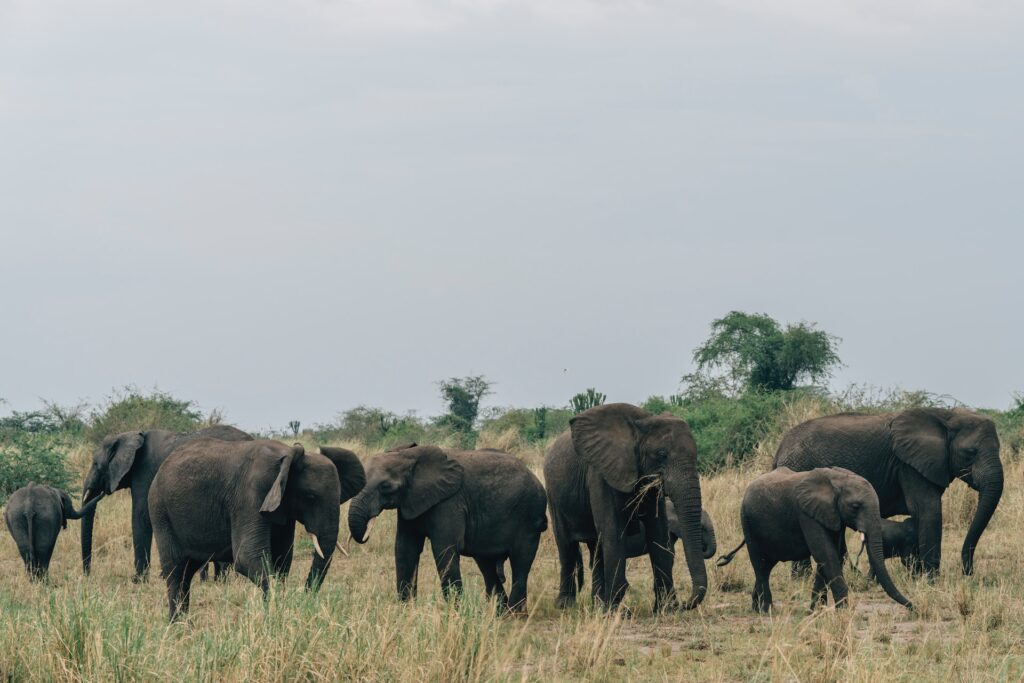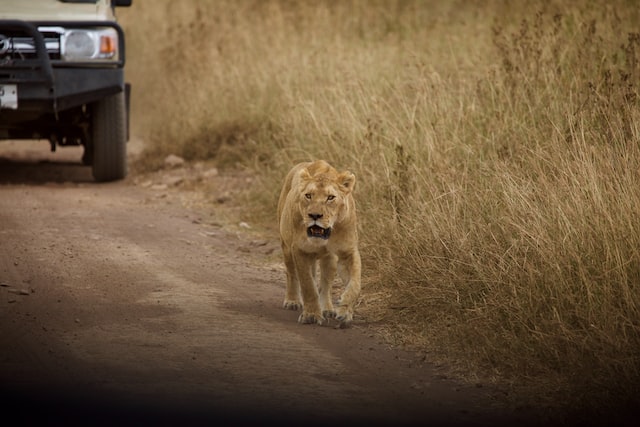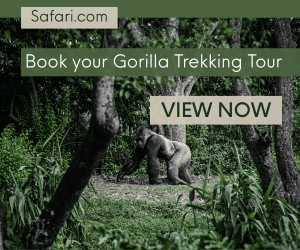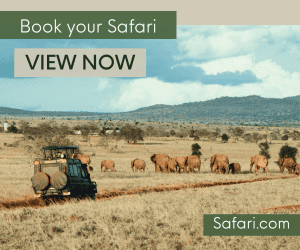Table of Contents
- Ten Essential Queen Elizabeth Self Drive Safari Tips!
- Tip #1: Hire a good vehicle (4WD is essential!)
- Tip #2: Consider hiring a ranger
- Tip #3: Pack supplies and fill up with fuel
- Tip #4: Don’t drive off the tracks
- Tip #5: Drive slowly
- Tip #6: Animals always have the right of way
- Tip #7: Don’t get out of the car
- Tip #8: Ask guides for animal sighting tips
- Tip #9: Plan your exit
- Tip #10: Enjoy the experience!
- The bottom line: Planning your Queen Elizabeth Self Drive Safari
Planning a Queen Elizabeth self-drive safari? If so, you’ve come to the right place!
Queen Elizabeth National Park is situated in southwestern Uganda and is one of the main tourist destinations in the country.
As a result, lots of people plan a Queen Elizabeth National Park self-drive while on vacation in Uganda, as it’s a truly memorable experience amidst a stunning natural environment.
I’ve lost count of how many times I’ve embarked upon a self-drive safari in QENP, as I live just thirty minutes from the park entrance.
My recent forays into the park have been to try and catch a glimpse of the elusive shoebill – Uganda’s legendary pre-historic bird – but I’m yet to be successful! There’s always another time.
But on my last trip to Queen Elizabeth, I had the idea to put together this blog post to provide information to people heading into the park for the first time without a guide.
So, without further ado, here are ten Queen Elizabeth self drive safari tips that will help you plan your trip to one of Uganda’s premier tourist destinations.
Ten Essential Queen Elizabeth Self Drive Safari Tips!
Heading out into the wilderness on your own terms is the best thing about a self-drive safari. So, to prepare for your adventure, here are ten essential Queen Elizabeth self drive safari tips to bear in mind!
Tip #1: Hire a good vehicle (4WD is essential!)
Queen Elizabeth National Park actually has a main road running through it from Kasese to Kihihi. But that doesn’t mean that the roads are in good shape, and the vast majority of the ‘main’ road is murram, not tarmac.
All of the tracks within QENP are essentially dirt tracks, and a 4WD is an absolute essential, particularly when you enter the park during the wet season. If you’ve never driven in sub-Saharan Africa before, you will quickly come to realize the value of a 4WD after a short time in the park!
There are several car hire companies operating in Uganda, but I highly recommend RoadTrip Africa. I’ve hired a vehicle from them on three separate occasions, and I’ve never once had a problem with the car or the level of service provided.
If you’re planning a self-drive in QENP, you should opt for at least a Toyota Rav4, but you can also opt for a slightly bigger vehicle like a Land Cruiser if you wish. RoadTrip Africa offers 4WDs starting from around $50 per day, which is about the cheapest you can expect in Uganda for car hire.
Tip #2: Consider hiring a ranger
Now that you’ve got your hire car, it’s time to head to the park. When you arrive at Queen Elizabeth National Park, you will have to pay a park entrance fee (per 24 hours you plan to spend there) as well as a charge for the vehicle itself.
The cost of park entrance changes from time to time, but you can find the current cost of entering the park here, thanks to the latest information from the Uganda Wildlife Authority (UWA).
When you arrive at the park entrance, you will be offered the opportunity to hire a ranger. This is essentially an armed UWA official who will escort you through the park, helping you navigate the tracks and potentially improving your chances of spotting elusive animals like lions and leopards.
You don’t need to hire a ranger, and every time I have done a self-drive safari in QENP, I’ve gone it alone, without a park ranger in the vehicle. Still, it’s worth considering if you’re visiting the park for the first time, as it can enhance the experience.
You can find the fees associated with hiring a ranger in the UWA information pack linked above.
Tip #3: Pack supplies and fill up with fuel
Queen Elizabeth National Park is a vast wilderness with very little in the way of supplies when you enter the park. The towns of Kasese and Kihihi at either end of the park are your best options for stocking up on supplies, depending on the route that you take into the park.
My advice is to fill your car up with fuel before reaching the park (obviously!), and the same is true for food and drink. Unless you’re planning lunch at one of the lodges in the park, there are only a few local trading centers (there’s one by the Kazinga Channel, for instance) where you can stock up on supplies.
So, to make sure you’re all set before reaching the park, load the trunk with water, snacks, and other essential supplies just in case you get stuck in the mud and are awaiting rescue! It can get pretty hot out on the savannah, so you need to have an adequate supply of water in the vehicle – just in case.
Tip #4: Don’t drive off the tracks

When you enter the park for the first time, you will likely be giddy with excitement (I always am!). You have this incredible wilderness in front of you that’s all yours to explore and the chance to see some stunning wildlife in the process.
Queen Elizabeth NP is connected via a number of tracks that have been given different names for ease of navigation. You can actually buy a map from the park entrance (it’s around $10), and it’s a huge help when you get your safari underway, particularly if you don’t have a ranger in the vehicle with you.
It’s really important for several reasons that you don’t drive off the tracks. First and foremost, you’re not allowed to do so, and you will be slapped with a hefty fine (I think off-roading in the park results in a fine of $150).
It’s also a bad idea because the terrain immediately next to the track is unpredictable and could cause your vehicle to get stuck. Also, by heading off track, you might disturb the wildlife living in the long grass, which is a big no-no.
So, even if you spot a leopard up a tree that is not served by a track, keep your distance and respect the tracks – it’s unfair to go off-road and can land you in trouble.
Tip #5: Drive slowly
If you think the potholes on normal Ugandan roads are bad, wait until you get into Queen Elizabeth National Park. The tracks are poorly maintained and aren’t in great shape, no matter the time of year you visit.
So, it’s really important to take it easy and stick to the speed limit when you’re in the park. There’s no need to race around, as you could easily damage your vehicle by doing so.
What’s more, if you’re driving too fast, you risk missing out on some awesome wildlife sightings, as going on safari is all about looking carefully through the tall grass to see if you can spot something!
Ultimately, you’re on vacation – so there’s no need to rush around the park!
Tip #6: Animals always have the right of way
This might seem like an obvious thing to say, but animals always have the right of way in Queen Elizabeth National Park. The same is true for animals in every other wildlife reserve in East Africa.
The best way to look at it is that you’re a guest in the animal kingdom, and they have the right to do whatever is natural to them. If an elephant decides to stand in the middle of the road for 30 minutes, that’s his prerogative. You just have to sit and wait patiently for him to move!
This point goes hand in hand with the last one and is another reason why it’s so important to drive slowly within the park.
Wild animals are completely unpredictable, and you need to be driving slowly enough to stop suddenly if something jumps into your path unexpectedly.
Again, there’s no rush when you’re driving around the park, so take your time and be sure to give animals the right of way throughout your safari.
Tip #7: Don’t get out of the car
There’s something truly liberating about a Queen Elizabeth National Park self-drive. After all, you’re in the wilderness on your own, and there’s a great chance of spotting a huge range of wildlife.
But equally, some stretches of your safari can seem a little long and repetitive, given that the park is so big and there are only so many animals within its boundaries. But whatever you do, you should not be tempted to get out of the car.
QENP is home to lions, leopards, hippos, elephants, crocodiles, snakes, and a whole host of other animals that can potentially cause you harm. Even if you think the coast is clear, it’s impossible to know what’s around you, and you put yourself in danger if you step out of the vehicle.
If you want to go on a walking safari, you should head instead to Lake Mburo– Queen Elizabeth National Park is not the place to go wandering through the bush!
Tip #8: Ask guides for animal sighting tips

One of the only downsides of a Queen Elizabeth National Park self-drive is the fact that you don’t have a knowledgeable guide in the car with you. When you organize a safari through a tour company, the guide knows where animal sightings are most likely and is connected to other guides and park rangers who advise them where to go.
However, just because you don’t have a guide in the car, it doesn’t mean that you can’t take advantage of their knowledge. When you see a tourist vehicle pulled over on one of the tracks, take the initiative to engage the driver in conversation.
They will be more than happy to share their recent animal sightings with you and will tell you where to head if you’re looking for something in particular – the tree-climbing lions are perhaps QENP’s biggest draw!
If you don’t engage the guides that are currently within the park, you might not be able to find the best locations for specific sightings, so it’s an important step to take if you’re on a self-drive safari in Uganda.
Tip #9: Plan your exit
The Ugandan day runs from 7 am to 7 pm, and this correlates with the opening and closing times of the national park. It gets dark in Uganda immediately after 7 pm, and you’re not allowed in the park after dark.
I’ve been caught out by this on several safaris, and it’s not a pleasant experience! It’s extremely difficult to see where you’re going in the dark of night, and of course, it’s a lot more dangerous to be out alone at night.
Therefore, to avoid getting stuck in the park after dark, make sure you plan your exit. What I mean by this is that you shouldn’t be heading to the middle of the park at 5 pm, leaving you several hours away from an entrance/exit when the hours of darkness arrive.
Of course, on a pre-arranged safari, your guide will deal with timings. But when you’re on a Queen Elizabeth National Park self-drive, you’re responsible for leaving the park at the right time.
So, consult your map and make sure that you’re not too far away from an exit as 7 pm approaches.
Tip #10: Enjoy the experience!
My final Queen Elizabeth self drive safari tip is a simple one – enjoy the experience!
Sure, there’s a lot to think about in order to prepare for a Queen Elizabeth National Park self-drive, but the main thing is that you need to enjoy the experience!
It will prove to be an extremely exciting adventure, and you will find that it will almost certainly be memorable for all the right reasons.
The bottom line: Planning your Queen Elizabeth Self Drive Safari
If you follow the tips listed in this guide, I’m sure you’ll have a successful trip to Uganda’s most impressive national park, and I hope you have a wonderful time.
Should you have any questions about your upcoming self-drive safari, or if you want to share tips with other travelers, leave a comment below!
If your upcoming Queen Elizabeth self drive will be your first experience of driving in Uganda, check out my recent post containing tips for driving in Uganda as a tourist!
You might also find my step-by-step instructions to planning a self-drive safari useful, as you prepare for your trip to Queen Elizabeth National Park.




